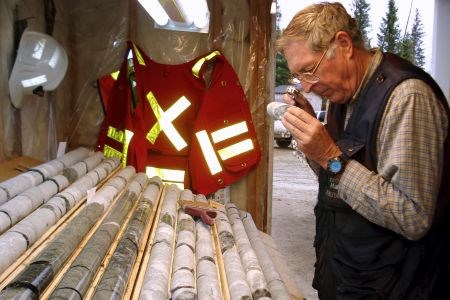Goldeye Explorations is striking while the iron is hot and right now, gold is the mineral of choice in the emerging Shining Tree district.
Blaine Webster, president and CEO of the Richmond Hill-based junior miner, knows the importance of mineral development when the market is strong.
“Sandy Lake and Shining Tree are the hinterland,” he said.
“I think it is important to make sure these projects go ahead,” he added, warning that there is a narrow window through which money flows to support resource development projects within the overall commodity cycle.
Sandy Lake and Shining Tree are two of several projects Goldeye has been working on.
The remote Sandy Lake property, 200 kilometres north of Red Lake, is 50 square kilometres.
Its geology is similar to Red Lake, with a chip sample returning six metres of 11 grams per tonne of gold (g/t Au).
Talks for a winter drill program are in progress with the Sandy Lake First Nation.
In the northeastern portion of the province, Goldeye has focused on its Shining Tree property in Tyrrell Township, located 90 kilometres south of Timmins.
The property is approximately 34 square kilometres, while a separate 28 claim units are located in the Leonard and Fawcett Townships, hosting a potential nickel-copper deposit.
It is accessible by paved and gravel roads and there is hydro on the property.
Webster, a geophysicist who works on regional patterns, said the geology in the Shining Tree district is similar to other areas that host significant gold deposits in the Abitibi Greenstone Belt, like Timmins and Kirkland Lake.
Consequently, Goldeye staked the property in 1990 when the Temagami Land Caution opened up.
The land caution was a First Nation protest in the ‘70s against development on Crown land in the Temagami area, encompassing 10,000 square kilometres.
Goldeye began its Tyrrell property exploration as a grassroots project, optioning the property to a junior that discovered Hydro Creek in 1993.
Goldeye went public in 1998 and discovered the Big Dome 1.5 kilometres to the southeast of Hydro Creek.
It is using technology called borehole induced polarization (IP) with 3-D inversions to capture complete images of the rock surrounding the boreholes in order to locate the sulfides in which gold often occurs.
These targets are then drilled.
Webster said the same technology was used at the Lake Shore Gold deposit in Timmins and by QuadraFNX Mining in Sudbury.
To date, the company has isolated two deposits, drilled 32 kilometres in about 110 holes, and has spent approximately $6 million.
The two deposits are about 1.5 km apart, and have gold mineralization over strike lengths of 500 metres.
Last year, 10,000 metres were drilled.
The two gold-bearing areas on the Tyrrell Shear Zone are called the Big Dome and Hydro Creek.
The Big Dome has two zones: the High Grade Zone and West Iron Formation.
The High Grade Zone has five holes that average 1.4 metres of 120 g/t Au, and the West Iron Formation is showing wide intersections of 4.40 g/t Au over 3.0m and 6.39 g/t Au over 2.9 m.
The Hydro Creek area’s LaCarte Zone provided wide intersections of gold averaging 5.8 g/t Au over 15 metres in a saw cut.
In the main Hydro Creek Zone, hole 23 had 6.4 g/t Au over 6.5 metres.
“I think in the 1930s, this was a tough place to get at,” Webster said, describing the 20 metres of sand covering the two exploration areas.
He said they’ve focused on the two zones and continue to prove up gold.
Goldeye also has a joint venture project with Temex Resources Corp. (40 per cent owned by Goldeye) and a 25-per-cent carried interest with Creso Exploration Inc.
A first-phase 2,500-metre 15-hole diamond drill program on the JV Juby property with Temex will test six target areas with up to 30 g/t of gold grab samples taken from surface throughout January and February 2011.
This program is in addition to the 7,000-metre drill plan proposed by Goldeye this year at the Shining Tree project, budgeted at approximately $1.2 million.
With a focus on work leading up to a 43-101 resource estimate, the company is encouraged by the markets and surrounding juniors focused on similar goals in the area.
www.goldeye.ca




